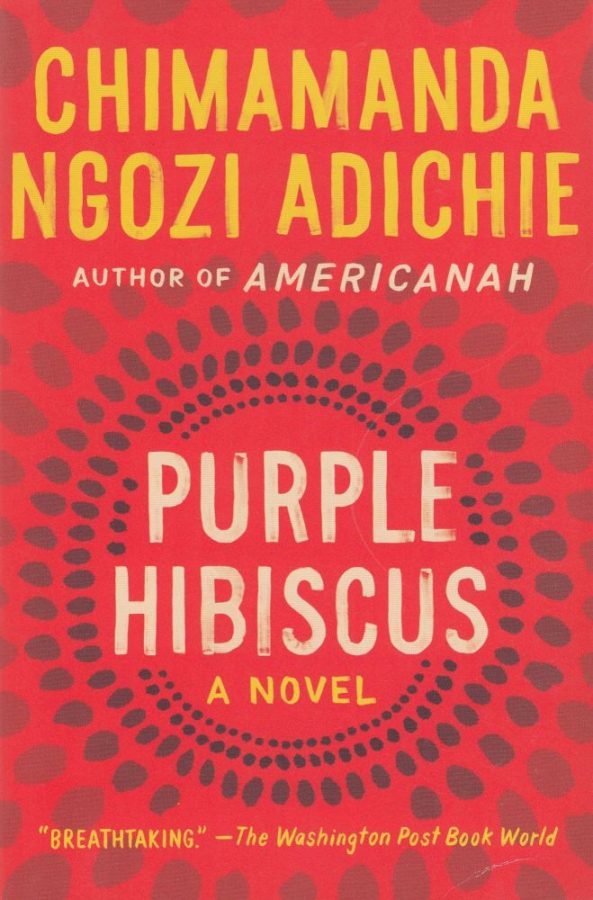More than Just a Plot
“Being defiant can be a good thing sometimes,” Aunty Ifeoma said. “Defiance is like marijuana – it is not a bad thing when it is used right,” – Purple Hibiscus. Even though the previous is a random phrase from her first book Purple Hibiscus, it not only sums up the moral of the novel but Chimamanda Ngozi Adichie’s attitude towards the world. Published in 2003, Adichie began writing her critically acclaimed novel Purple Hibiscus as a college student. Following the coming-of-age story of 15-year-old Kambili, this book explores the influence of religious dogma in both the intra and interpersonal relationships of all the main characters. Ultimately, Adichie challenges the reader to reflect upon world issues through an implicit critique of religion as a means for abuse and an exploration of the vast divergence between socioeconomic classes during the Biafran war. Taking a lesson for her book, Adichie analyzes humanity through a critical lens and is not worried about posing questions “whose answers we did not want to know.”
To be defiant, Adichie has to cleverly approach the reader, often at the expense of intricate plots. Going in with a direct critique of popular practices in society will limit her audience. Therefore, Adichie embodies her inner Lord Voldemort by hiding the truth within the lines of the novel. Instead of directly introducing the personalities of the main characters, she places them in a typical scene that can occur in the reader’s life. In the case of Purple Hibiscus, the novel begins by recounting an issue at church. Although not the typical idea for an interesting exposition, Adichie allows her characters to show their behavior in regards to others, introducing key elements of how they will behave throughout the story. Even if this scene provides a slow start to the coveted book, it relies on imagery that allows the reader to become a part of the novel and provides them with elements to draw their conclusions on the characters’ despicable behavior. If Adichie tells readers what to think versus showing them and letting them form their own opinions, then they will never listen to the true meaning behind her words. A similar strategy can be witnessed in her award-winning novel Americanah where the plot becomes personal to such extent that by the end of the book, readers claim they have read Adichie’s autobiography. Although the plot is not the strongest element in either book, the way readers can make the story their own allows the author to manipulate the reader, Slytherin style, into questioning unpopular topics such as gender, race, religion, power, and wealth.
Furthermore, as a means to continue exploring the prominence of social issues and the way they shape culture, characters in Purple Hibiscus constantly face obstacles that emphasize the world’s injustices while providing the reader insight into their minds. Similar to the strategies Ralph Ellison used in his thought-provoking novel Invisible Man, after slyly introducing her characters, Adichie uses comparisons and explores her characters’ inner thoughts to analyze their lived-experience. For instance, Purple Hibiscus analyzes the socioeconomic divide by contrasting the experience of Kambili, the main character, whose life revolved around private school and fancy mansions, to the one of her cousins, whose electricity and water were cut unexpectedly every week. When exploring the different lifestyles of the characters in the book, Adichie sheds light on the characters’ opinions regarding prominent social issues by combining the viewpoints of both parties into the same scenes. Throughout these scenes, the readers empathize with both parties and their points of view. In a similar fashion, Ellison addresses the social and intellectual issues African-Americans faced in the early 20th century by letting the reader into the mind of the narrator, who is also the unnamed main character, when he is faced with choosing between embracing his identity or gaining money. The strategy of allowing the reader into the characters’ minds allows them to get invested in a plot that transcends entertainment to become a defiant critique of society.
Aside from giving the reader exclusive insight into the character’s thoughts, Purple Hibiscus enhances the connection between the audience and the novel by combining elements of fiction and non-fiction. Even though most of Adichie’s books are classified as fiction, the imagery and factual accuracy of her stories might suggest they are non-fiction. For instance, A Long Way Gone by Ishmael Beah is a memoir, yet when describing the typical African town and soldiers in the streets, Beah and Adichie’s descriptions are not divergent. The imagery found in Purple Hibiscus transports the reader into the average African town that is covered in dirt roads and street sellers, while intimidating policemen control the entrance to the main market. Soon the reader begins to confuse reality with fantasy and starts believing Adichie’s words as life’s truths. This phenomenon blurs the words in the pages until their message can be transported to the realities of the world outside the book covers.
Due to Adichie’s constant need to defy societal realities and look for answers to questions most people are too afraid to ask, her books turn from fictional entertainers to intricate critiques. With Purple Hibiscus, the reader is trapped in a fictional (or not) world of religious supremacy where money represents power and the right to abuse family members. Without readers knowing, they are getting a crash course in systemic injustices. Even if Adichie becomes a little manipulative, “ ‘the tyrants continue to reign because the weak cannot resist. Do you not see that it is a cycle? Who will break that cycle?’ ” – Purple Hibiscus.




